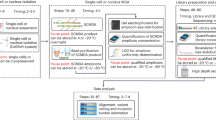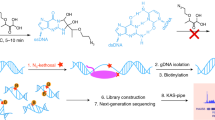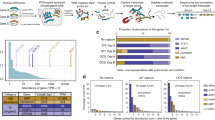Abstract
Modifications to exon amplification have been instituted that increase its speed, efficiency and reliability. Exons were isolated from target human or mouse genomic DNA sources ranging from 30 kilobases (kb) to 3 megabases (Mb) in complexity. The efficiency was dependent upon the amount of input DNA, and ranged from isolation of an exon for every 20 kb to an exon for every 80 kb of target genomic DNA. In these studies, several novel genes and a smaller number of genes isolated previously that reside on human chromosome 9 have been identified. These results indicate that exon amplification is presently adaptable to large scale isolation of exons from complex sources of genomic DNA.
This is a preview of subscription content, access via your institution
Access options
Subscribe to this journal
Receive 12 print issues and online access
$209.00 per year
only $17.42 per issue
Buy this article
- Purchase on Springer Link
- Instant access to full article PDF
Prices may be subject to local taxes which are calculated during checkout
Similar content being viewed by others
References
Monaco, A.P. et al. Isolation of candidate cDNAs for portions of the Duchenne muscular dystrophy gene. Nature 323, 646–650 (1986).
Page, D.C. et al. The sex-determining region of the human Y chromosome encodes a finger protein. Cell 51, 1091–1104 (1987).
Rommens, J.M. et al. Identification of the cystic fibrosis gene: chromosome walking and jumping. Science 246, 1059–1065 (1989).
Call, K.M. et al. Isolation and characterization of a zinc finger polypeptide gene at the human chromosome 11 Wilms' tumor locus. Cell 60, 509–520 (1990).
Fearon, E.R. et al. Identification of a chromosome 18q gene that is altered in colorectal cancers. Science 247, 49–56 (1990).
Bird, A. CpG-rich islands and the function of DNA methylation. Nature 321, 209–213 (1986).
Liu, P., Legerski, R. & Siciliano, M.J. Isolation of human transcribed sequences from human-rodent somatic cell hybrids. Science 246, 813–815 (1989).
Corbo, L., Maley, J.A., Nelson, D.L. & Caskey, C.T. Direct cloning of human transcripts with hnRNA from hybrid cell lines. Science 249, 652–655 (1990).
Jones, K.W., Chevrette, M., Shapero, M.H. & Fournier, R.E.K. Generation of region-and species-specific expressed gene probes from somatic cell hybrids Nature Genet. 1, 278–283 (1992).
Lovett, M., Kere, J. & Hinton, L.M. Direct selection: A method for the isolation of cDNAs encoded by large genomic fragments. Proc. natn. Acad. Sci. U.S.A. 88, 9628–9632 (1991).
Parimoo, S., Patanjali, S.R., Shulka, H., Chaplin, D.D. & Weissman, S.M. cDNA selection: Efficient PCR approach for the selection of cDNAs in large genomic DNA fragments. Proc. natn. Acad. Sci. U.S.A. 88, 9623–9627 (1991).
Duyk, G.M., Kim, S., Myers, R.M. & Cox, D.R. Exon trapping: a genetic screen to identify candidate transcribed sequences in cloned mammalian genomic DNA. Proc. natn. Acad. Sci. U.S.A. 87, 8995–8999 (1990).
Auch, D. & Reth, M. Exon trap cloning: using PCR to rapidly detect and clone exons from genomic DNA fragments. Nucl. Acids Res. 18, 6743–6744 (1990).
Buckler, A.J. et al. Exon amplification: a strategy to isolate mammalian genes based on RNA splicing. Proc. natn. Acad. Sci. U.S.A. 88, 4005–4009 (1991).
Church, D.M. et al. Identification of human chromosome 9 specific genes using exon amplification, Hum. molec. Genet. 2, 1915–1920 (1993).
Vulpe, C., Levinson, B., Whitney, S., Packman, S. & Gitschier, J. Isolation of a candidate gene for Menkes disease and evidence that it encodes a copper-transporting ATPase. Nature Genet. 3, 7–13 (1993).
Trofatter, J.A. et al. A novel moesin-, ezrin-, radixin-llke gene is a candidate for the neurofibromatosis 2 tumor suppressor. Cell 72, 791–800 (1993).
Taylor, S.A.M. et al. Cloning of the α-adducin gene from the Huntington's disease candidate region of human chromosome 4 by exon amplification. Nature Genet. 1, 697–703 (1992).
Ambrose, C. et al. A novel G protein-coupled receptor kinase maps to the Huntington's disease candidate region. Hum. molec. Genet. 1, 697–703 (1992).
Duyao, M.P. et al. A gene from 4p16.3 with similarity to a superfamily of transporter proteins. Hum. molec. Genet. 2, 673–676 (1993).
The Huntington's Disease Collaborative Research Group. A novel gene containing a trinucleotide repeat that is expanded and unstable on Huntington's disease chromosomes. Cell 72, 971–983 (1993).
Vidal, S.M., Malo, D., Vogan, K., Skamene, E. & Gros, P. Natural resistance to infection with intracellular parasites: Isolation of a candidate for Bcg. Cell 73, 469–85 (1993).
Mardon, H.J., Sebastio, G. & Barelle, F. A role for exon sequences in alternative splicing of the human fibronectin gene. Nucl. Acids Res. 15, 7725–7773 (1987).
Cooper, T.A. & Ordahl, C.P. Nucleotide substitutions within the cardiac troponin T alternative exon disrupt pre-mRNA alternative splicing. Nucl. Acids Res. 17, 7905–7921 (1989).
Hodges, P.E. & Rosenberg, L.E. The spfash mouse: a missense mutation in the ornithine transcarbamylase gene also causes aberrant mRNA splicing. Proc. natn. Acad. Sci. U.S.A. 86, 4142–4146 (1989).
Weil, D. et al. A base substitution in the exon of a collagen gene causes alternative splicing and generates a structurally abnormal polypeptide In a patient with Ehlers-Danlos syndrome type VII. EMBO J. 8, 1705–1710 (1989).
Akli, S. et al. A “G” to “A” mutation at position–1 of a 5′ splice site in a late infantile form of Tay-Sachs disease. J. biol. Chem. 265, 7324–7330 (1990).
Vasan, N.S. et al. A mutation in the pro alpha 2(l) gene (COL1A2) for type I procollagen in Ehlers-Danlos syndrome type VII: evidence suggesting that skipping of exon 6 in RNA splicing may be a common cause of the phenotype. Am. J. hum. Genet. 48, 305–317 (1991).
Craig, S.P., Buckle, V.J., Lamouroux, A. & Mallet, J. Localization of the human dopamine beta hydroxylase (DBH) gene to chromosome 9q34. Cytogenet. Cell Genet. 48, 48–50 (1988).
Altschul, S.F., Gish, W., Miller, W., Myers, E. & Lippman, D.J. Basic local alignment search tool. J. molec. Biol. 215, 403–410 (1990).
Lindern, M.V. et al. The translocation (6;9), associated with a specific subtype of acute myeloid leukemia, results in the fusion of two genes, dek and can, and the expression of a chimeric, leukemia-specific dek-can mRNA. Molec. cell. Biol. 12, 1687–1697 (1992).
Adams, B. et al. Pax-5 encodes the transcription factor BSAP and is expressed in B lymphocytes, the developing CNS, and adult testis. Genes Dev. 6, 158–1607 (1992).
Stapleton, P., Weith, A., Urbanek, P., Kozmik, Z. & Busslinger, M. Chromosomal localization of seven PAX genes and cloning of a novel family member, PAX-9. Nature Genet. 3, 292–298 (1993).
Lidberg, U. et al. Genomic organization, sequence analysis, and chromosomal localization of the human carboxyl ester lipase (CEL) gene and a CEL-like (CELL) gene. Genomics 13, 630–640 (1992).
Williams, M.E. et al. Structure and functional expression of an omega-conotoxin-sensitive N-type calcium channel. Science 257, 389–395 (1992).
Adams, M.D. et al. Complementary DNA sequencing: expressed sequence tags and human genome project. Science 252, 1651–1656 (1992).
Obar, R.A., Collins, C.A., Hammarback, J.A., Shpetner, H.S. & Vallee, R.B. Molecular cloning of the microtubule-associated mechanochemioal enzyme dynamin reveals homology with a new family of GTP-binding proteins. Nature 347, 256–261 (1990).
Takenaga, K., Nakamura, Y., Tokunaga, K., Kageyama, H. & Sakiyama, S. Isolation and characterization of a cDNA that encodes mouse fibroblast tropomyosin isoform 2. Molec. cell. Biol. 8, 5561–5565 (1988).
Hempel, W.M. & DeFranco, A.L. Expression of phospholipase C isozymes by murine B lymphocytes. J. Immunol. 146, 3713–3720 (1991).
Bellefroid, E.J. et al. The human genome contains hundreds of genes coding for finger proteins of the kruppel type. DNA 8, 377–387 (1989).
Ayer, D.E., Kretzner, L. & Eisenman, R.N. Mad: a heterodimeric partner for max that antagonizes myc transcriptional activity. Cell 72, 211–222 (1993).
Kwiatkowski, D.J. et al. Report and abstracts of the Second International Workshop on Human Chromosome 9 Mapping 1993. Cytogenet. Cell Genet. 64, 93–121 (1993).
Henikoff, S., Keene, M., Fechtel, K. & Fristrom, J. Gene within agene: nested Drosophila genes encode unrelated proteins on opposite strands. Cell 44, 33–42 (1986).
Williams, T. & Fried, M. A mouse locus at which transcription from both DNA strands produces mRNs complementary at their 3′ ends.Nature 322, 275–277 (1986).
Spencer, C., Gietz, D. & Hodgetts, R. Overlapping transcription units in the DOPA decarboxylase region of Drosophila. Nature 322, 279–281 (1986).
Adelman, J.P., Bond, C.T., Douglass, J. & Herbert, E. Two mammalian genes transcribed from opposite strands of the same locus. Science 235, 1514–1517 (1987).
Duin, M.V. et al. Conserved pattern of antisense overlapping transcription in the homologous human ERCC-1 and yeast RAD10 DNA repair gene regions. Molec. cell. Biol. 9, 1794–1798 (1989).
Okubo, K. et al. Large scale cDNA sequencing for analysis of quantitative and qualitative aspects of gene expression. Nature Genet. 2, 173–179 (1992).
Khan, A.S. et al. Single pass sequencing and physical and genetic mapping of human brain cDNAs. Nature Genet. 2, 180–185 (1992).
Warburton, D. et al. Monochromosomal rodent-human hybrids from microcell fusion of human lymphoblastoid cells containing an inserted dominant selectable marker. Genomics 6, 358–366 (1990).
Sanger, F., Nicklen, S. & Coulson, A.R. DNA sequencing with chain terminating inhibitors. Proc. natn. Acad. Sci. U.S.A. 74, 5463–5467 (1977).
Innis, M.A., Myambo, K.B., Gelfand, D.H. & Brow, M.A.D. DNA sequencing with Thermus aquaticus DNA polymerase and direct sequencing of polymerase chain reaction-amplified DNA. Proc. natn. Acad. Sci. U.S.A. 85, 9436–9440 (1988).
Author information
Authors and Affiliations
Rights and permissions
About this article
Cite this article
Church, D., Stotler, C., Rutter, J. et al. Isolation of genes from complex sources of mammalian genomic DNA using exon amplification. Nat Genet 6, 98–105 (1994). https://doi.org/10.1038/ng0194-98
Received:
Accepted:
Issue Date:
DOI: https://doi.org/10.1038/ng0194-98
This article is cited by
-
Insights into the pathophysiology of DFNA10 hearing loss associated with novel EYA4 variants
Scientific Reports (2020)
-
Functional characterization of BRCA1 gene variants by mini-gene splicing assay
European Journal of Human Genetics (2014)
-
The silent mutation nucleotide 744 G → A, Lys172Lys, in exon 6 of BRCA2 results in exon skipping
Breast Cancer Research and Treatment (2010)
-
ALDH1A2 (RALDH2) genetic variation in human congenital heart disease
BMC Medical Genetics (2009)
-
Novel de novo BRCA2mutation in a patient with a family history of breast cancer
BMC Medical Genetics (2008)



